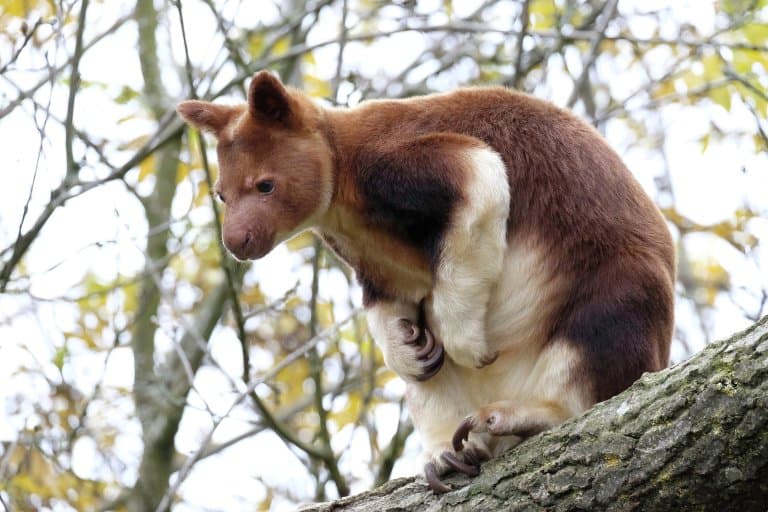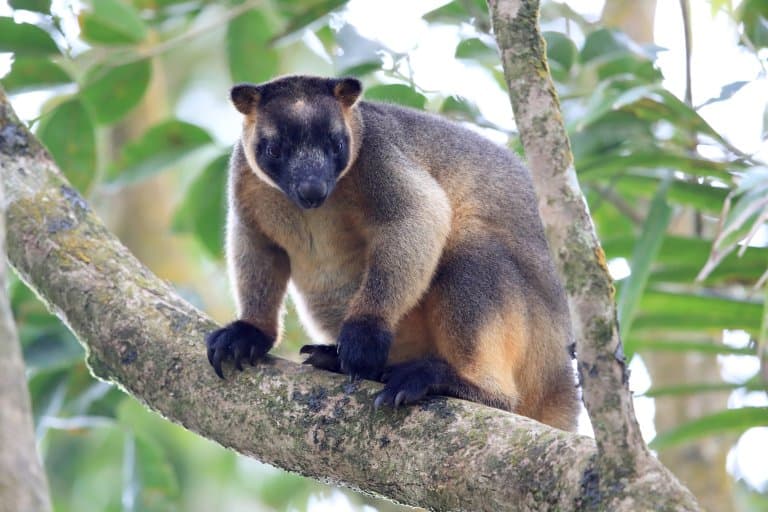Tree Kangaroo Profile
Not many people realise this, but kangaroos aren’t limited to the terrestrial world.
Several species added a third dimension to their popular habitat and went back up into the branches to hop, skip and jump between trees.
These are the tree kangaroos: a lesser-known branch of macropods whose lack of popularity has contributed to their endangerment.
They are marsupials in the same family as kangaroos, wallabies, and quokkas that inhabit the rainforests of Northeastern Queensland, Indonesia and New Guinea.

Tree Kangaroo Facts Overview
| Habitat: | Rainforest canopy |
| Location: | Northern Australia and Papua New Guinea |
| Lifespan: | Around 14 years in captivity, around 8 in the wild |
| Size: | 48 – 90 cm (19 – 35 inches) in large species |
| Weight: | 6 – 15 kg (13 – 33 lb) |
| Color: | Mostly red, grey or black |
| Diet: | Leaves, fruit, grains and sap |
| Predators: | Local communities and feral dogs |
| Top Speed: | 5 kph on the ground |
| No. of Species: |
14 |
| Conservation Status: |
Vulnerable – Grizzled tree-kangaroo, Ursine tree-kangaroo, Doria’s tree-kangaroo, Seri’s tree-kangaroo, Goodfellow’s tree-kangaroo, Lowlands tree-kangaroo Near Threatened – Lumholtz’s tree-kangaroo, Bennett’s tree-kangaroo Endangered – Matschie’s tree-kangaroo, Ifola, Dingiso Critically Endangered – Golden-mantled tree-kangaroo, Tenkile, Wondiwoi tree-kangaroo |
Tree kangaroos do exactly what it says on the tin. These elusive and unique mammals occupy some important niches in the forest canopies of Papua New Guinea and Northern Australia, and despite being some of the biggest animals in the trees, are not well-known locally or globally.
There are generally accepted to be 14 species of tree-kangaroo, ranging from the smallest Lumholtz’s tree-kangaroo at 48–65 cm (19–26 in) in length, to the largest grizzled tree-kangaroo, which can range between 75–90 cm (30 to 35 in) and weigh up to 15kg.
The main diet of tree kangaroos is fruit, leaves, bark, nuts and sap. They have special front teeth for cutting stems, while their rear molars are good for grinding them. Some species are omnivorous and will also eat birds, snakes, insects and eggs.
Many species are now facing extinction as a result of deforestation, and there isn’t a lot of public awareness to support them. But with increased education both among local tribes and urban populations worldwide, a demand for their conservation is growing.
Interesting Tree Kangaroo Facts
1. They are kangaroos
This might seem obvious or come as a surprise, depending on which way you look at it.
But tree kangaroos aren’t just colloquially related by to their terrestrial namesake; they are thought to have evolved to return to the branches from a common ancestor with the kangaroos we’re more familiar with.
These ancestors moved down from the trees at some point, and then a handful decided they didn’t like it very much on the ground and went back up again.
The tree kangaroos then became Australia’s largest tree-dwelling mammals, sharing some traits with their skippy brethren and adopting some new ones for their arboreal life. 1

2. Their tails are counterweights
Many species spend their time a long way from the forest floor, and they use their tails for balance. These long, pendulous fifth limbs hang down to lower their centre of gravity on a branch, acting as ballast and increasing stability in the canopy.
While possums can climb down trees head-first, this enormous tail means that on the rare occasion a tree kangaroo needs to hit the earth, they need to back down carefully!
Once they’re on the ground they’re a lot more cumbersome. Their maximum hobble is said to be around 5 kph.
3. They have the longest gestation of any marsupial
The female Matschie’s tree-kangaroo, D. matschiei, gestates for longer than any other marsupial at around 45 days. This might not seem like long, but as with other marsupials, the offspring is born barely formed and must clamber blindly into the pouch to fully develop.
This joey is around 2cm long when it makes this journey, and it will stay there for almost a year before it can live independently.
This slow breeding cycle is one of the reasons this species is now endangered and will always be vulnerable to population declines. 2
4. They can still jump!
Despite leaving the long-distance hopping to their terrestrial cousins, tree kangaroos haven’t lost the ability to jump. They’re capable of leaping from tree to tree, sometimes as far as 18 meters down.
When leaping, their heavy tail is used again like a counterweight, arched upward to prevent them from tipping over.
5. Boongarry
This name refers to a species of tree kangaroo that hold a special position in the culture of its local tribes. Lumholtz’s tree kangaroo, known as Boongarry, was held in high regard and protected by the Ngadjon-Jii people of the Atherton Tableland.
Unfortunately, these protections were not afforded to boongary or any of the other species by most tribes, or indeed the European colonisers who have reduced most species to at least Near Threatened status with widespread habitat destruction. 3

6. They’re fed tea
In captivity, tree kangaroos have little access to the natural diet they’d find in the wild. Zoos often don’t have a supply of Australian rainforest flora to hand, and the tree kangaroo is used to a certain level of tannin in its meals.
The tree kangaroo diet includes a lot more toxins and plant defences than that of the grass-eating ground-dwelling variety, and so these need to be substituted to keep captive animals healthy.
Zoos discovered that feeding tree kangaroos on tea leaves seems to do the trick. The animals’ slow metabolism allows them to handle much higher levels of these toxins than most. 4
7. The Wondiwoi tree-kangaroo was considered extinct
The Wondiwoi tree-kangaroo is critically endangered and lives exclusively on the island of New Guinea (in eastern Indonesia).
This species is so rare and elusive, is was considered extinct until 2018, when it was rediscovered in unexplored dense bamboo thickets at a high altitude. Before that this species was only known from a single specimen collected back in 1928.
While their population number is unknown, it’s thought there was less than 50 living in the wild today.
8. The key to their protection is education
Everyone knows what a koala is, and pandas are one of the most popular icons for conservation, but the lesser-known or somewhat unpopular animals often slip through the cracks.
It’s been shown that in order to protect unique and obscure animal species, more people need to know that they exist and why they’re important.
Even people positive about conservation are shown to be more supportive of tree kangaroo protection after receiving additional information on wildlife species they know less about.
This means we can all help with conservation. Even for species, we don’t share space with, simply becoming aware of their existence, their significance and the threats against them can help us spread the word and increase support for their protection. 5

9. And they are important
Tree kangaroos make up a significant contribution to the forest ecosystem. As nutrient recyclers and seed dispersers, they help maintain the local environment for other animals to live in, too.
Unsustainable hunting practices have been responsible for their decline in some regions, and conservationists have seen significant improvements in multiple species populations after persuading hunters to avoid them as a food source. 6
10. Other marsupials have lent a hand, well pouch!
When his mother was killed by a falling tree branch, an orphaned tree-kangaroo joey was moved to the pouch of a yellow-footed rock-wallaby by the Adelaide Zoo in 2014.
Incredibly, the tree kangaroo joey survived after being effectively raised by the rock-wallaby substitute mother.
Tree Kangaroo Fact-File Summary
Scientific Classification
| Kingdom: | Animalia |
| Phylum: | Chordata |
| Class: | Mammalia |
| Infraclass: | Marsupialia |
| Order: | Diprotodontia |
| Family: | Macropodidae |
| Genus: |
Dendrolagus |
| Species Names: |
Grizzled tree-kangaroo (D. inustus) Lumholtz’s tree-kangaroo (D. lumholtzi) Bennett’s tree-kangaroo (D. bennettianus) Ursine tree-kangaroo (D. ursinus) Matschie’s tree-kangaroo (D. matschiei) Doria’s tree-kangaroo (D. dorianus) Ifola (D. notatus) Seri’s tree-kangaroo (D. stellarum) Goodfellow’s tree-kangaroo (D. goodfellowi) Golden-mantled tree-kangaroo (D. pulcherrimus) Lowlands tree-kangaroo (D. spadix) Dingiso (D. mbaiso) Tenkile (D. scottae) Wondiwoi tree-kangaroo (D. mayri) |
Fact Sources & References
- “Tree Kangaroo“, World Wildlife Fund.
- “Dendrolagus matschiei, Huon tree kangaroo“, Animal Diversity Web.
- Woinarski, J. & Burbidge, A.A. (2016), “Dendrolagus lumholtzi“, The IUCN Red List of Threatened Species 2016.
- Judie Steenberg and Jacque Blessington (2001), “TREE KANGAROO (Dendrolagus spp.) Nutrition Husbandry Manual“, Woodland Park Zoo Seattle, Washington.
- Clem Tisdell & Clevo Wilson (2004), “The public’s knowledge of and support for conservation of Australia’s tree-kangaroos and other animals“, SpringerLink.
- Cressida Stevens (2020), “Why people and forests need tree kangaroos“, BirdLife International.
